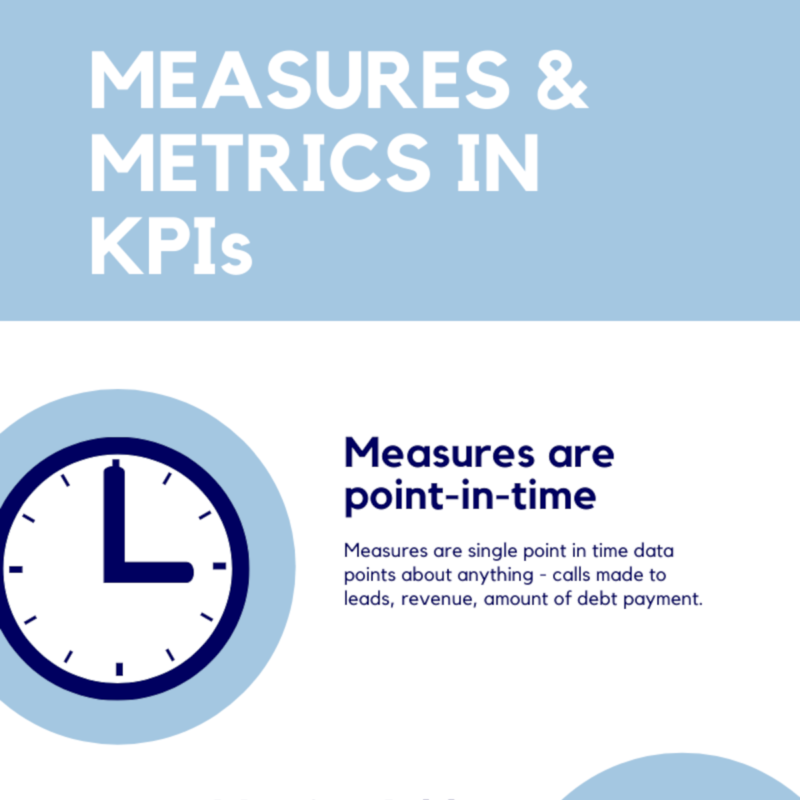Key Performance Indicators, or KPIs, are quantifiable measures and metrics we use to evaluate the performance of our business. Many times, we’ll use these same data points to set goals and improve the performance of our business, not just evaluate it.
But what is the difference between measures and metrics?
Measures Are Point-in-Time Data Points About Almost Anything

We use measures every day and don’t realize it. In the general world, this looks like:
- Cups of coffee for breakfast.
- Cups of coffee before noon.
- Gallons of gas purchased.
- Pieces of mail.
In business, this looks like:
- Number of calls made to leads.
- Number of sales made.
- Revenue.
- Cost of Goods.
- Profit.
And so on.
Measures are easy and they’re all around us.
However, quite often, when taken on their own, measures don’t mean much of anything. For example, if I told you we made $100,000 in revenue, great! But wouldn’t you want to know over what time period? After all, there’s a big difference if we made that in one year vs. in one week or even one day.
That knowledge, the context of the measure, is what we gain with metrics.
Metrics Add Context by Combining Measures

Quite literally, metrics are nothing more than the combination of measures. If you want to get fancy, we say that metrics are derived from measures. To derive a metric, we combine at least two measures.
I’m not fancy, so I say metrics are what happen when measures make a “per” sandwich. Look what I mean.
- Calls per sale
- Revenue per month
- Cost of Goods per month
Truth is that example falls apart and does not apply to every metric, but at least you get what I mean. Metrics are the combination of measures. Let’s go through a few more examples.
- Net New Customers – This is Customers Added less Customers Dropped for the month (or other time period)
- Employee Productivity – Or, Revenue per Employee
- Lead to Close Ratio – Or, the number of Leads it takes to win one deal.
In reality, a lot of these metrics in reality become things like “Average Revenue” but that’s still a derived metric, or if you prefer a combination of multiple metrics — Total Revenue divided by number of months.
The point is metrics are nothing more than measures that provide context for each other through a little math.
![]()
Download the KPI Planning and Tracking Worksheet
Save hours of work by starting with a pre-made Excel Workbook featuring examples, explanations, and built-in calculations.
How We Use Measures & Metrics at Pivot Habit

As you go through the next sections learning about KPIs, you’re going to find that I’m big on planning out KPIs. In other words, I do not like just identifying them and measuring how we do along the way. Noooo, dear friend.
As a little preview of what we do with KPIs, just as soon as we identify KPIs, we create a Performance Budget. Just as you budget your money for the year (um, you DO do that, right?), we do the same with our KPIs. We plan out the performance we want to see on each.
That’s super important as you’re about to see in about a 10 second read from now…
Which is Better: Measures or Metrics?

This is a trick question. In reality it doesn’t matter, but smart people like to argue about this and make you think does matter. It. Doesn’t. Matter. Use what is appropriate for the question you’re trying to answer. Let’s look at an example of why.
Say you’ve tapped your credit line for $150,000 and you want to keep close tabs on the payback. You set a goal to pay back $6,000 at a time. Great.
Technically, “Payment” is a measure. You paid $6,000. That’s one data point. That is by definition a measure.
Some really smart people will tell you NEVER to track and use measures but only ever use metrics. So example metrics in this case would be either:
- Growth of Payment – This doesn’t tell us anything about what we want to know, so this is out.
- Line of Credit Utilization – If this is expressed as a percentage, it doesn’t do us much good (e.g. 67% utilized last month vs. 62% utilized this month). If expressed as a dollar amount, it sort of gets at what we want to know, but indirectly (e.g. $100,500 balance last month vs. $93,000 this month).
As you can see, if you look around, their might be a metric that captures the information you want to know. If there is, great. It is true that a general rule of thumb is that metrics usually capture more information and drive more performance. But that’s not always the case.
Here’s the thing. At minimum, in my method, you’re always going to be breaking your KPIs down into per month data points. So no matter what data point you use, you’ll end up expressing a metric. The question for you is data what best answers the question you’re asking. Most often that’s a metric, but sometimes a measure is what is called for.
Back to Index | Next: Outcome and Performance Metrics
![]()
Download the KPI Planning and Tracking Worksheet
Save hours of work by starting with a pre-made Excel Workbook featuring examples, explanations, and built-in calculations.


